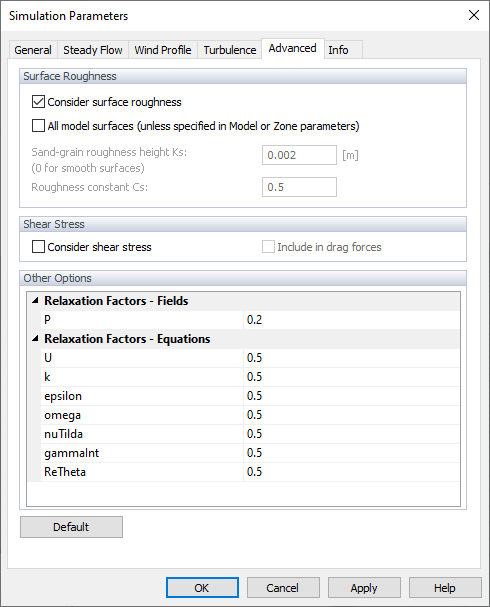Surface Roughness Parameters
If the texture of the model surfaces has a major effect on the results, activate the "Consider surface roughness" check box. The roughness will then be taken into account for every surface of the model. Specific boundary conditions are applied to the surfaces or zones, providing surface constraints on the turbulent viscosity to account for roughness effects.
For the program to determine turbulent viscosity near the surfaces, the "Sand-grain roughness height Ks" needs to be specified. You can define the size of the sand grains in the text box. Note that the value is to be entered in meters.
The "Roughness constant Cs" controls the shape and spacing of the sand grains. This parameter is set as 0.5 by default, assuming a homogeneous distribution. If there is a non-uniform roughness, though, Cs can be increased up to 1.0.
Shear Stress
This section is only available for the calculation of Steady flow for now. The display of shear stress can be enabled by selecting the "Shear stress results" option, the results are available after the calculation in the Surface Quantities results. It is also possible to include the shear stress in the Cauchy stress tensor and subsequently in the resulting Drag Force, using the "Include forces" option. More about shear stress can be found in Chapter Surface Quantities, Surface Shear Stress .
Other Options
In RWIND 2, it is possible to set "Relaxation Factors" for the OpenFOAM® calculation. The relaxation factors are closely related to the stability and the convergence of the calculation. In general, the relaxation factors specify the amount by which a quantity changes from the previous iteration to the next one. There is no effect at all for the factor equal to 1 and the effect increases as the relaxation factor approaches zero. The limiting case of 0 represents a case where the solution does not change at all with successive iterations. Therefore, the admissible value of the relaxation factor should be greater than 0 and less than or equal to 1.
An optimum choice for the relaxation factor is the one that is small enough to ensure stable computation, but large enough to move the iterative process forward quickly.
